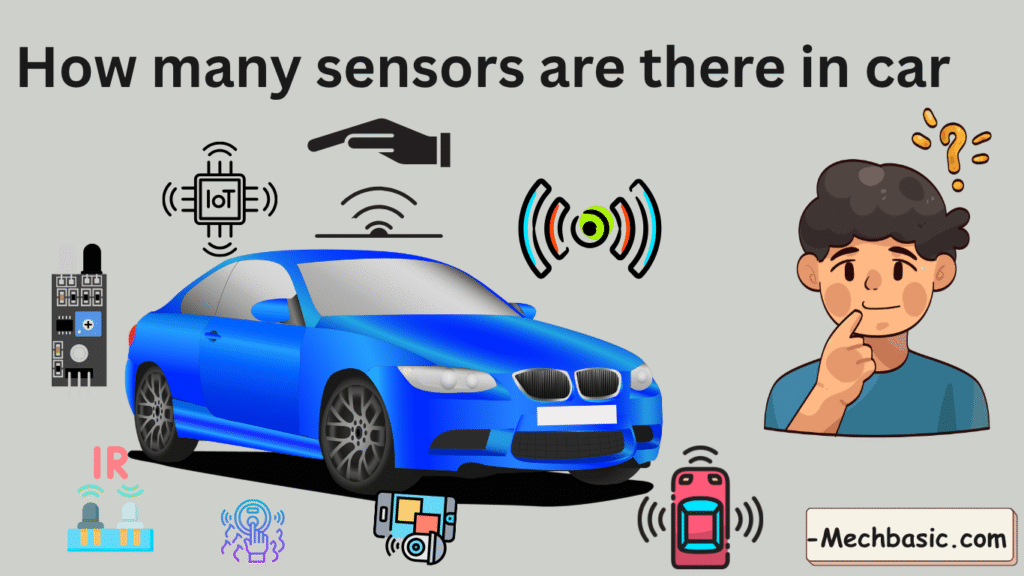The number of sensors in a modern car can vary widely depending on vehicle type, technology, and features, but let’s break it down in detail:
 How many sensors are in a car?
How many sensors are in a car?
1. Overview
- Modern cars have anywhere from 30 to 100+ sensors.
- Luxury, electric, or high-tech vehicles can have up to 150 sensors or more.
- Sensors are used for:
- Engine and transmission management
- Safety systems (ABS, airbags, stability control)
- Comfort and convenience (climate control, automatic lights)
- Emission control and fuel efficiency
- Advanced driver-assistance systems (ADAS) in modern cars
2. Common Types of Sensors in a Car
A. Engine and Transmission Sensors
| Sensor | Function |
|---|
| Crankshaft Position Sensor | Monitors engine RPM and piston position |
| Camshaft Position Sensor | Assists in ignition and valve timing |
| Mass Air Flow (MAF) Sensor | Measures incoming air for fuel calculation |
| Oxygen (O2) Sensor | Monitors exhaust gases for optimal air-fuel ratio |
| Throttle Position Sensor (TPS) | Measures throttle opening |
| Engine Coolant Temperature Sensor | Monitors engine temperature |
| Knock Sensor | Detects engine knocking/pinging |
| Vehicle Speed Sensor (VSS) | Measures car speed |
| Transmission Fluid Temp Sensor | Monitors transmission temperature |
B. Brake and Safety Sensors
| Sensor | Function |
|---|
| Wheel Speed Sensors | Used for ABS and traction control |
| Brake Pressure Sensor | Monitors hydraulic pressure |
| Airbag Crash Sensors | Detect impact for airbag deployment |
| Steering Angle Sensor | Helps stability control and lane assist |
| Parking Sensors / Ultrasonic Sensors | Assist in parking and collision avoidance |
C. Comfort and Convenience Sensors
| Sensor | Function |
|---|
| Rain / Light Sensor | Controls automatic wipers and headlights |
| Cabin Temperature Sensor | Regulates climate control |
| Occupancy / Seat Sensors | Detect passenger presence for airbags |
| Tire Pressure Sensors (TPMS) | Monitor tire pressure in real-time |
| Fuel Level Sensor | Measures fuel tank level |
D. Advanced / ADAS Sensors
| Sensor | Function |
|---|
| Lidar / Radar Sensors | Adaptive cruise, collision avoidance |
| Cameras | Lane-keeping assist, traffic sign recognition |
| Ultrasonic / Proximity Sensors | Parking assist, obstacle detection |
| GPS Module | Navigation, geofencing features |
3. Factors Affecting Number of Sensors
- Vehicle Type: Luxury cars, EVs, and modern sedans have more sensors.
- Transmission Type: Automatic and CVT cars require more sensors than manual cars.
- Safety Features: ABS, ESC, traction control, and airbags increase sensor count.
- ADAS Features: Lane assist, adaptive cruise, blind-spot detection add multiple sensors.
- Emission Standards: Cars in regions with strict emissions regulations have more engine and exhaust sensors.
4. Summary
- Older cars (pre-2000): 10–20 sensors, mainly for engine and basic safety.
- Modern mid-range cars: 30–60 sensors.
- Luxury / electric / high-tech cars: 80–150+ sensors, including ADAS and comfort features.
- Sensors are essential for engine control, safety, efficiency, comfort, and driver-assist technologies.
Other courses:







